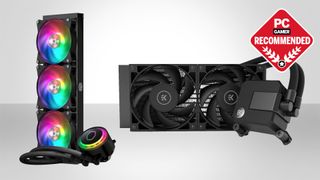Chemical Haptics could bring touch sensations like cold and heat to VR
Finally, a way to feel something.
It's somewhat staggering how far VR has come in recent years. Household devices are by no means uncommon and cost about as much as your standard console. With rigs like the Oculus Quest 2, you don't even need a computer or cables to get that VR immersion on demand.
But Virtual Reality is all about the big dream. It's not called Virtual Close to Reality. VR is about making experiences feel real in ways other mediums just can't yet. New products release all the time like VR treadmills and haptic body kits to try to enhance the experience, but there's just so much nuance we can't yet translate to digital worlds.
However, one more reality hurdle is being aptly leapt over by a team at the University of Chicago (via New Scientist). Jasmine Lu, Ziwei Liu, Jas Brooks, and Pedro Lopes are developing a new kind of haptic feedback they've dubbed chemical haptics, and it sounds super cool. As well as warm, tingly, and numb.
Lu's website talks about a paper that's soon to be released to the public. It shows off two devices built by the team which deliver liquid stimulants to the skin of the person wearing them. They're soft silicone patches that sit on the skin and use micropumps to pass the chemicals through to the wearer. One goes across the face over the bridge of the nose, delivering chemicals to the cheeks while the other sits on the forearms.

Best AIO cooler for CPUs: All-in-one, and one for all... components.
Best CPU air coolers: CPU fans that don't go brrr.
The abstract explains that the team worked with different chemicals to deliver different sensations. Five chemicals were found to deliver lasting results in safe doses, though my sensitive skin does worry somewhat. Sanshool provides a tingling feeling, lidocaine for numbing, cinnamaldehyde sounds wonderful and causes stinging sensations, and warming and cooling are delivered by capsaicin and menthol respsectively.
The team worked on five different VR experiences with the chemical haptics and users rated these as much more immersive with the new tech than without.
The use cases for gaming are pretty exciting. Being able to simulate weather in games with hot and cold sensations does sound like it would be very immersive. Feeling the heat from a nearby explosion or a numbing sensation on an injured body part are also interesting concepts. Maybe in the near future we'll all be purchasing chemical packs for our VR machines to really feel the burn.
The biggest gaming news, reviews and hardware deals
Keep up to date with the most important stories and the best deals, as picked by the PC Gamer team.
But that's not all these teams are working on. There's a device to increase dexterity for electrical muscle stimulation. Another that changes the way objects feel when you touch them, and a whole bunch of touch related research. I'm excited to see what games of the future will look like with people like this on the case.

Hope’s been writing about games for about a decade, starting out way back when on the Australian Nintendo fan site Vooks.net. Since then, she’s talked far too much about games and tech for publications such as Techlife, Byteside, IGN, and GameSpot. Of course there’s also here at PC Gamer, where she gets to indulge her inner hardware nerd with news and reviews. You can usually find Hope fawning over some art, tech, or likely a wonderful combination of them both and where relevant she’ll share them with you here. When she’s not writing about the amazing creations of others, she’s working on what she hopes will one day be her own. You can find her fictional chill out ambient far future sci-fi radio show/album/listening experience podcast right here. No, she’s not kidding.
Most Popular






